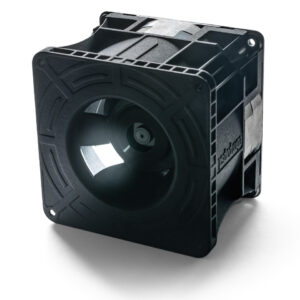Mr. Stern, why is there a need for a new compact fan for electronics cooling?
Data volumes are constantly increasing in telecommunications and automation technology. Cooling these powerful electronics systems is becoming a real challenge, as the number of axial compact fans cannot be easily increased. This is due to the little available installation space and the noise protection requirements.
How did you solve this problem?

Christian Stern, Product Manager at ebm-papst in St. Georgen (Photo | ebm-papst)
We combined our international development expertise to come up with a new approach. The close collaboration between our Mulfingen, St. Georgen and Shanghai sites resulted in the design and development of a new diagonal compact fan, one that meets future requirements and has the same dimensions as a conventional solution: the DiaForce.
What is new about the DiaForce?
In terms of its characteristics, it is a hybrid between an axial and a centrifugal fan. To achieve this, we fitted the fan impeller with a conical cover plate that surrounds the ends of the blade. There is no longer a tip gap which would lead to a drop in pressure and turbulence at the edge. As the outlet opening of the fan impeller is larger than the intake opening, the air flows through the fan in both an axial and a radial direction.
“The DiaForce is six dB(A) quieter than a conventional axial compact fan — with up to 50 percent higher air performance.”
What are the benefits of that?

The DiaForce diagonal fan combines features of axial and centrifugal fans. (Photo | ebm-papst, Gernot Walter)
This design ensures a high pressure increase. It also enables much lower noise levels. Thanks to the aerodynamic optimizations, the DiaForce is six dB(A) quieter than a conventional axial compact fan — with up to 50 percent higher air performance. The axial design, which is cheaper for installation, is retained nevertheless.
What role does the motor play in this increase in performance?
The EC motor with an output of 500 watts is very compact and operates at a high level of efficiency. Its electronics make a major contribution to this: a high-performance microcontroller operates a field-oriented control system that ensures the maximum possible torque in all load ranges and also optimizes efficiency and structure-borne noise.
How does this much power impact the service life?
The results are very positive. And what is even better is that, with the optional FanCheck function, we can offer a smart maintenance concept. FanCheck constantly calculates the statistical service life based on the actual operating conditions. This means that the costs for the replacement can be optimized in the planning.

Leave a comment